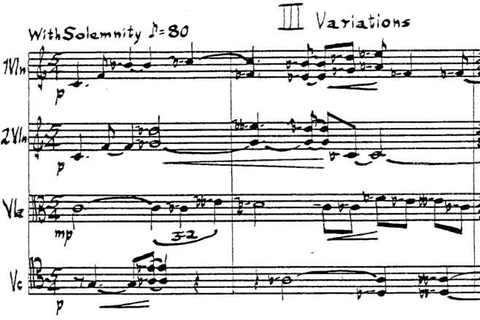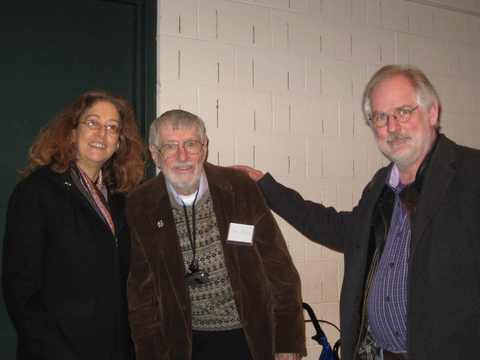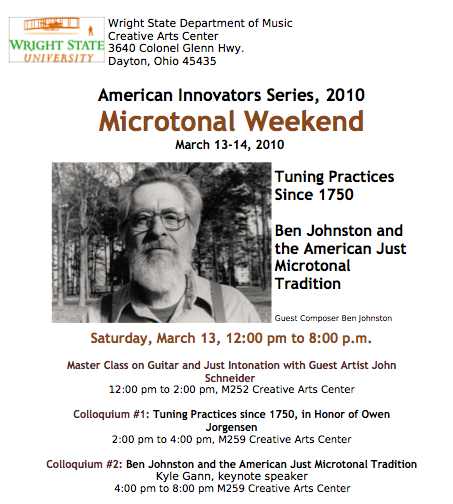PostClassic: March 2010 Archives
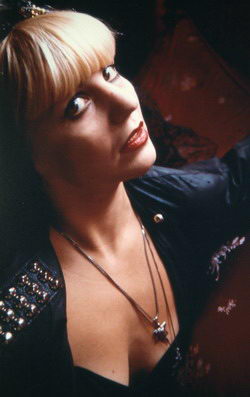
1. The Son
2. Enoch
3. Love
4. Faith
5. The Word
One of the best things the Microtonal Weekend at Wright State University did for me was initiate me into familiarity with Ben Johnston's Seventh String Quartet. Written in 1984, the piece has never been played. It has a reputation as being the most difficult string quartet ever written. Timothy Ernest Johnson of Roosevelt U. gave a paper analyzing the third movement (his doctoral dissertation is on the entire work and also Toby Twining's Chrysalid Requiem), and for the first time I learned exactly wherein that difficulty consists.
If you know much about Ben's Third Quartet, you know it works its way measure by measure through a 53-note microtonal scale. The finale of the Seventh is built on a similar plan, but the structural tone row consists of 176 pitches - all different, 176 pitches within one octave, heard in the viola on each successive downbeat. Many other notes are heard in the other instruments whose harmonies link each note to the next, and Tim tells me that altogether there are more than 1200 discrete pitches in the movement - more than one per cent, five times as many as most people can perceive. That does sound a little tricky to play. Tim demonstrated how the players are supposed to proceed from the opening C to the subsequent D7bv-, a pitch ratio of 896/891. The violist is tasked to move upward from this C and come back down on a pitch 9.7 cents higher - just under one tenth of a half-step - than she started on. At the downbeat of the next measure, the violist lands on Dbb--, pitch ratio 2048/2025 - another ten cents higher. And so on for another 175 measures until the viola ends up traversing the octave and ends at C again. A good half of Tim's paper was spent talking us through the performance challenges of the first two measures. Between the first and second downbeats (pictured below), the quartet is supposed to tune the F to the C and the Bb- to the F, the Ab- and Eb- in the cello to the Bb- in the first violin and the 7th harmonic G7b- above that, and find the 11th subharmonic below G7b-, and, voilà, viola, you're on D7bv-. It's just 4/3 x 4/3 x 2/3 x 2/3 x 7/4 x 8/11, and bob's your uncle, there's your 896/891. It can't be too much more difficult than four people traversing a 177-meter tightrope together without holding hands, or manually flying four biplanes in parallel in and out of the mountains through a dense fog. I mean, it's not like they're calculating all this while playing an accelerating tempo canon, for god's sake.
The tempo is slow and the rhythms relatively simple, though there are serialized aspects to the rhythm and meter, correlated to pitch differences in the row. Ben recalled that his original proportional scheme would have made the piece last 48 years. Tim Johnson was applauded by others in the audience who had tried to untie this Gordion's knot and failed; he's been working on it for five years, and developed a set of computer programs to help him process the cascades of pitches and ratios. Best of all, he played a MIDI version of the movement's opening 30 measures. It was, indeed, breath-taking: consonances slid into slightly new consonances in recurring patterns, but with no sense of a background fixed pitch grid whatever. [UPDATE: Tim kindly sent me the MIDI file to post, so listen for yourself. It's done with piano sounds, so imagine a string quartet playing it.] I think I can truly claim that never, in the history of the world's music, has such deeply-layered complexity sounded so translucent.
I have bowed low before many an unfathomable musical achievement, but before this one I absolutely prostrate myself. Imagine Ben writing in pencil, in 1984, a string quartet that would later require multiple computer programs to unravel again! How can a mere MIDI-piano version of 30 measures of a yet-unperformed work change your ideas of what music can achieve? Boulez and Stockhausen, you are hereby blown out of the water, your musical understanding has been revealed as merely rudimentary by this Burj Khalifa of sonic conceptualization. The Kepler Quartet, from whom violinist Eric Segnitz was present for the conference, is expected to record the piece for their series of Ben's complete quartets on New World. Good. Luck.
Thankfully, due to another analysis paper by Daniel Huey of U. Mass., we also got to hear Ben's Tenth Quartet (1995), which I'd also never heard before. This is a considerably simpler piece, and in fact the final movement is a theme and variations on the tune "Danny Boy," which isn't revealed until the very end. The harmonies are tight, fluid, elegantly voice-led, and creamy. The Kepler's next CD (SQs 1, 5, and 10) comes out in October, and I guarantee you'll enjoy the 10th. Its simplicity-within-complexity and complexity-within-simplicity will gratify biases all across the spectrum, and with its resonantly pure yet exotic chords it just sounds great.
* * * * * * * * * * * * * * * * * * * * * *
In other news drawn from the colloquium (which was astonishingly dense with relevant news, considering it flew by in a mere 29 hours), the other honoree was the late piano tuner Owen Jorgensen, who wrote the massive book on the history of keyboard tuning manuals in English, Tuning (I won't take the time to look up its voluminous subtitle). Momilani Ramstrum of Mesa College talked about Jorgensen's life and said that he rather embarrassed Michigan State as their staff piano tuner by becoming more of a celebrity than most of the faculty, so they made him a full professor and let him teach piano tuning. On the other hand, registered piano technician Fred Sturm of UNM gave a polite but exhaustive tirade against Jorgensen's influence, charging that since he limited himself to British sources, and Britain was a few decades behind the Continent on tuning issues, he's created a misleading picture of tuning history that others (myself included) are now quoting uncritically. This sounds perfectly plausible, and doesn't interfere with the pleasure I get from Jorgensen's passionate speculations about the relation of composing to tuning. However, it turns out there's a new tome in English now by Patrizio Barbieri simply called Enharmonic which contains a more accurate and voluminous documentation of the history of tuning all across Europe and across the centuries. You can obtain it, as I soon will, at Barbieri's web site, and I will expect you all to have read it before I blog on the subject again. Frank Cox passed around a copy, and it looks massively impressive.
Microtonal guitarist John Schneider, slapping an endless series of interchangeable fretboards on his axe, started us out with a 100-minute introduction to the history of tuning that hit every salient point, made every principle clear, demonstrated every nuance beautifully on the guitar, and was thoroughly delightful and entertaining. If you ever need a lecturer on this topic, he's your man. I couldn't have done it. In five hours or 15 weeks I can make a lot of good points about tuning, but he's distilled it into a compact traveling road show. And John Fonville led a group of students though a continuum of perfectly tuned tone clusters in Partchian otonalities and utonalities whose beauty we could all appreciate. He's looking to take that to various schools as well. If I can ever get these guys up to Bard, I will jump at the opportunity.
Ben Johnston offered some lovely reminiscences on his education and career, which microtonal composer Aaron Hunt quotes on his blog, so I refer you there. Aaron gave his own colorful presentation on the microtonal instruments he's selling through his Hπ company, to whose web site http://www.h-pi.com/index.html I additionally direct you. Thanks to Franklin Cox and Wright State University for a colloquium that delivered more punch per presentation than just about any academic event I've ever attended.
I'll only add that, in addition to what Aaron quotes, Ben Johnston and I shared a moment I'll never forget. After my address in his honor, he hugged me and said, "Thank you, thank you, thank you." I replied, "Ohhhh, thank you." And he looked me right in the eye with the old twinkle I remember from decades past, and growled cheerfully: "You're welcome!" False modesty on his part would have been devastating at such a moment. For him to acknowledge some small honor I could pay him was pleasant, but for him to acknowledge what he'd done for me - spinning my life off in a direction I hadn't anticipated, yet one that expressed perfectly what I needed to do - was ten thousand times more fulfilling. If decades hence any student ever thanks me for my impact on his or her life, I'll remember how important the words "You're welcome" can be.
You can't make a living giving keynote addresses, but through repetition you can become proficient enough at them to take them in stride. Here's my keynote address honoring my teacher Ben Johnston, for the Microtonal Weekend at Wright State University, organized by composer and microtonal cellist Franklin Cox:
* * * * * * * * * * * * * * * * * * * * * * * * *
Charles Ives once fantasized about "some century to come, when the school children will whistle popular tunes in quarter-tones." It has long seemed to me that when I hear people whistling popular tunes, quarter-tones are indeed often involved, but I think what Ives had in mind was that the popular tunes would be written in intentional quarter-tones. I don't think this is likely to happen in my lifetime, but I do think that, thanks to several other important composers, Ben Johnston chief among them, the time may soon come when musicians feel free to hit the occasional seventh or even eleventh harmonic in their music, vernacular and otherwise.
I
love listening to quarter-tone and sixth-tone music. It instantly puts you into
a world in which our habitual musical categories fall apart. You lose the
moorings that every musician gets trained into, and the rational part of your
brain, the part that can analyze and identify what we hear, gets
short-circuited, and has to surrender to pure sonic experience. However, in
general I find that, in a long quarter-tone piece, the delicious strangeness
becomes uniform, and settles into a monochrome grayness. It's like being
dropped on an unfamiliar planet: the initial thrill of exoticness gives way to
relentless disorientation. The quarter-tone musical universe is too strange, and difficult to get used to. In this world the
composer, faced with all those new available pitches - though of course there
are sensitive exceptions in the music of Wyschnegradsky, Eaton, and others -
the composer tends to exclude the
familiar, and thus minimize contrast.
This
is the principle according to which Ben Johnston's microtonal music - and not
only his music, but his entire approach to music - has always seemed stronger
to me, more inviting, and more enduring in its appeal. Its starting point is
the harmonies that have been used in music for hundreds of years. From that
point it grows outward into more exotic harmonics, which we learn by hearing,
as the fineness of our pitch discrimination increases, to incorporate into what
we are already familiar with. Theoretically speaking, Ben, like Harry Partch
before him, does not take a sudden left turn from 1920, as the quarter-tone
composers did, but goes back to the tuning arguments of the 16th century and starts over. For the Renaissance musician, a sharp multiplied a
musical frequency by the fraction 25/24 - and so does it in Ben's music. In
Renaissance music, major triads represented a set of tones vibrating at ratios
of 4, 5, and 6 - and so they do for Ben. The C major scale represented the
center of the musical universe, and a take-off point for more exotic phenomena
- and so it does for Ben.
What
happened in the 16th century, limiting our musical resources for the
next 300 years, is that a decision was made to exclude the number 7, and all
larger prime numbers, from our theoretical vocabulary. Under English influence
in the 15th century during Henry V's war of occupation, French
theorists were convinced to expand their tuning arsenal from 2 and 3, the
octave and perfect fifth, to 5, which gave them a consonant major third as
well. But when they came to the number 7, the seventh harmonic, despite the advocacy
of certain intelligentsia like Nicola Vicentino and the famous mathematician
Marin Mersenne, the theorists balked. The victorious Zarlino insisted on the
infamous senario, the numbers 1 through 6, as the basis of musical consonance.
He argued by analogy on the grounds that there are six directions (up, down,
right, left, forward, and backward), six zodiac signs (as long as you count
only the ones visible above the horizon), six visible planetary bodies (as long
as you don't count the Sun), and so on. That there are seven days of the week,
let alone 13 full moons a year and a 19-year cycle of sun and moon phases, he
seems to have conveniently overlooked. The decision was cultural, political,
and even racist, besides being sixist.
The hindus and arabs used prime tuning numbers larger than 5, and the good
Catholics of 16th-century Italy were not going to follow the path of
the heathens. And so for over 300 years, Europe and then America sweated by on
12 impoverished pitches only designed for the playing of simple triads.
This
was the decision that Harry Partch set out to undo in 1928 when he burned his
early music in a pot-bellied stove in New Orleans and started over with the 7th and 11th harmonics. It was Ben Johnston's contribution to create a
notation in which to think musically with the 7th, 11th,
and even higher harmonics, and to pursue an expansion of acoustic-instrument
performance practice with those harmonics.
The
fact is probably already familiar to this audience, but I will recount it
ritualistically, that in Ben's most famous work, his Fourth String Quartet
based on the common folk tune "Amazing Grace," he gave us a vivid template in
how to expand music through the harmonic series. The piece, as you all know, is
a set of variations. The first statement of the theme uses only the primitive
pentatonic scale of the French 14th century, based on ratios of 2
and 3 - also presumed to be the scale of rustic folk fiddling. The first
variation adds in the pure thirds added by the fifth harmonic. The fourth
variation adds so-called "blues" notes of the seventh harmonic, and the fifth
brings in the seventh subharmonic, until at the end the music traverses a
symmetrical 23-tone scale firmly anchored in the key of G- (that's G minus, not
G minor). At the very end, pitches are again subtracted precipitously, and the
music ends in a simple and familiar final cadence.
At the same time, of course, Ben opens the piece with the beat divided only into simple 8th-notes and triplets. When he adds in the fifth harmonic, he also adds quintuplets to the rhythm, and as he folds in 7th harmonics he adds in septuplets, in systems so intricate that one variation is based on a structural polyrhythm of 35 against 36, which also happens to be the pitch ratio difference between a 7th harmonic and a regular Renaissance-era minor seventh. In this mirroring of the same numbers in both harmony and rhythm, Ben achieves in the work a beautiful manifestation of the vision Henry Cowell sketched out imperfectly in his 1930 book New Musical Resources. In that book Cowell theorized that the languages of pitch and rhythm could be developed isomorphically rather than separately, as had been traditional. (Tomes have been written about Ben's microtonal usage, but his role as a rhythmic pioneer, I think, has never been sufficiently acknowledged.)
Had Ben never written another work, this piece, the Fourth Quartet, would have been a sufficient blueprint for how music could expand its resources magnificently in the 21st and 22nd centuries. It is an ontogeny on which a phylogeny could be fashioned. All of my own music has taken place, rhythmically and harmonically (even my non-microtonal music), within the expanded universe opened up by that piece - not simply because I studied composition with Ben, but because he solved, notationally, pragmatically, and creatively, the impasse posed by the premature moratorium on prime numbers higher than 5 adopted in the late Renaissance. (One could say something similar about Harry Partch, whose own rhythmic explorations have also been too little noted, but Ben solved it for those of us whose carpentry skills are less than impressive.)
I
first met Ben around 1976 when I was a student at Oberlin, but I didn't get to
know him until 1983. At a wonderful concert of his music in Chicago, I went up
to him and asked if I could study with him. I had already finished my
doctorate, but I had never studied regularly with a very famous composer, so I
asked to drive downstate to Urbana every now and then for a lesson with him. It
turned out that he was also traveling to Chicago frequently to attend a Zen
temple, and so sometimes I would meet him there instead, and eventually I
started attending the Zen services with him before our lesson. What I didn't
tell him was what I was saying to myself: that although I loved his music, I
wasn't going to get involved in this microtonality business, because it was too
much work for too little payoff.
Ben
never proselytized for microtonality. But in my very first lesson, he made a
casual comment about how nice one of my harmonies would sound if you tuned it
properly, and he reeled off the fractions. I had been the star math student of
my high school, and merely realizing that I possessed what it would take to
enter Ben's new harmonic world presented an attraction from which I was
helpless to draw back. He didn't need to encourage or convince me. I suddenly
realized at that moment that a door had just shut behind me, and there was no
return. I wrote very little music in my four years with Ben, but I filled
entire notebooks with pages and pages of fractions. Not until 1991 did I
finally manage to write a piece that was completely microtonal in conception,
that couldn't be meaningfully approximated on the piano. I figure Ben delayed
my composing career by five years. But he bestowed upon me the heady pleasure
of being able to compose harmonic progressions that had never been heard
before.
I
can't guess what might have happened if I had studied microtones with John
Eaton or Easley Blackwood instead, but I do know that Ben's approach made
intuitive sense to me because it started with the familiar and moved out
gradually and organically into the exotic - sometimes in a calculated and
dramatic fashion. I remember when I first started driving to Urbana that he
would first bring in and enthusiastically play me the music he was working on.
He'd start playing - I particularly remember this happening with his piece for
trumpet and piano The Demon Lover's Doubles - and the music would seem rather normal. A couple of
minutes later, I'd start thinking, "Gee, Ben's piano is badly out of tune,
you'd think he'd call a piano tuner." And then by the end of the piece his
piano would have become miraculously in tune again. I was stumped. I didn't
understand tuning enough at the time to realize what was happening; I know now
that his piano sounded more and more out of tune the further he strayed from
the central key it was tuned to.
I
want to replicate for you an experience Ben gave me once by playing you The
Demon Lover's Doubles. I used to have a
recording of this on cassette, but unfortunately it's been misplaced over the
years, and so I've made a MIDI version whose quality I apologize for, but that
will at least give an accurate representation of the tuning.
This is a subversive piece. It
draws you into a false sense of security and then suddenly [at 2:28 out of 4:10] throws you into an
abyss in which you doubt your own senses - and it does so with just a simple
12-pitch scale tuned to one key. Looking back, I'm embarrassed that at 28 I was
too ignorant to fully get the joke. I'm also glad that I was forced to make a
MIDI version, because it wasn't until I added the dynamics that I realized how
clever the conception is. The middle variation is loud and bangy, and then the
music turns mysteriously quiet just as the last four disorienting pitches get
added in. The whole scale is tuned to the key of D, but those last four pitches
- 15/14, 11/9, 15/11, and 14/9, if you're keeping track - load in two more
unexpected dimensions of the harmonic series. You've been riding along
comfortably with 2, 3, and 5, just as your family had done for generations, and
suddenly you get a visit from 7 and 11. This simple-sounding world is not what
you thought. It contains a portal to the demonic world - a world that studying
with Ben soon made me eager to enter. And the music raises your sense threshold
with its grand loudness before suddenly sinking down to a pianissimo level at which not only are you hearing something really
weird and unexpected, but you're not quite sure what you're hearing because it's suddenly so soft. It's one of
the great sucker punches in music. And in 1985 I was a great sucker.
I later found a more subtle example of Ben's pitch magic in his Suite for Microtonal Piano of 1977. In this piece the piano is tuned entirely to overtones of C, specifically the 1st, 3rd, 5th, 7th, 9th, 11th, 13th, 15th, 17th, 19th, 21st, and 27th harmonics. According to one of the prevailing misconceptions about just intonation, this should mean that only music in the key of C major should be playable in this scale. However, Ben couches the second movement in the key of D, and the fourth in the key of E with an interlude in G. Each of these movements sounds perfectly at home in its tonic key, yet each offers a different set of intervals to the tonic note, and thus a different repertoire of peripheral harmonies. In effect, Ben has invented the possibility of treating an unequal 12-pitch scale as a mode, with different potentials on each tonic. The scale contains only five perfect fifths, and it is on these fifths that Ben grounds his basic harmonies. Exotic intervals available on D that aren't available on C include the ratios 19/18, 11/9, 13/9, and 17/9. The range of chords on these pitches, which would sound jazzy but rather tame on a conventionally tuned piano, offer a vastly expanded range of consonance and dissonance of which Ben takes full advantage. The climactic chord progression ranges from a chord whose ratios would have to be analyzed as 27:32:44:52:72 down to one that is simple 2:3:4:6. This range provides an entirely new dimension between extremes of consonance and dissonance unknown in previous keyboard music. In 12-tone equal temperament, dissonance depends mostly on seconds and sevenths; on Ben's piano, one has not only those but strangely tuned thirds and sixths, a completely different flavor of dissonance - or as Harry Partch memorably put it: "an entirely different serving of tapioca.
I'd now like to contextualize all this with reference to Ben's quiet, little noted, but persuasive contribution as a music theorist. Though not as noisy or controversial about it as some other composers later were (notably one of his more outspoken students), he was probably, or seems so in retrospect, the first to publicly criticize serialism on theoretical grounds, and not from a conservative position, but from a radical one - not because it went too far, but because it didn't go far enough. Much later, Fred Lerdahl would write a paper about "cognitive constraints" in which he demonstrated that our brains are not wired to process permutations as musical phenomena; years later, George Rochberg would publicly stop writing 12-tone music and scandalize his colleagues by returning to Romanticism; soon, the first minimalists would return to writing in a diatonic scale. But before all of these, as early as 1959, Ben was writing about the limited intelligibility offered by an interval scale in a 12-tone context. In 1962 he drew on then-recent findings in experimental psychology to draw a distinction between nominal, ordinal, interval, and ratio scales:
A nominal scale is a collection of equivalent and interchangeable items. An ordinal scale is a collection which is rank-ordered in terms of some attribute. An interval scale is a rank-ordered collection in which the intervals of difference between items are equal. A ratio scale is a rank-ordered collection in which the items are related by exact ratios.... Each of these scales includes all of the measurement possibilities of its predecessors, plus one more.[1]
The major and minor scales of European tonality are ratio scales, because it is possible to judge the ratio of each frequency to the tonic. Twelve-tone method gives us only an interval scale, because all we can hang on to are a group of intervals whose size differences are uniform. It is because the methodology of 12-tone music allowed only for interval scales and not ratio scales that Ben was able to announce that, "in an important and basic way serialism is... a less sophisticated technique than tonal organization."[2] As long as the basis of music was triadic, he wrote, the out-of-tuneness of 12-tone equal temperament was of negligible importance, but in the long run the system offered an inadequate conceptual model for expansion. "When many of these usages become outmoded," he wrote,
and a search for new principles of musical organization begins, as has happened in the 20th century, the one-sided model provided by equal temperament becomes a serious but largely unrecognized limitation. When musical organization based upon a linear (interval) scale replaces that based upon a ratio scale, there is a net loss in audible intelligibility.[3]
Note, however, that unlike other composers who identified a fatal flaw in the 12-tone language, Ben didn't stop writing in it. I once asked him why, since he was a just intonationist, he continued to write 12-tone music, and he answered, "Well, I had learned all that technique, and I didn't want it to go to waste." In his 12-tone music, though, he applied his own critique as a reform. In his remarkable String Quartet No. 6, the first hexachord of the row is a harmonic series on D, and the second is an undertone series on D#. This means that all 12 notes of the row are not equal in weight, because one note in each half of the row is the fundamental from which the other five pitches are derived. The pitch matrix for this row contains 63 different pitches within the octave. The piece rocks back and forth between overtone series' and undertone series', in a thoroughly tonalized 12-tone technique.
Ben's point of view, reaching back into the Renaissance and breaking with some of his immediate contemporaries, brought him to take stands that were both radical and conservative. As he wrote in 1976:
Feeling that the harmonic mode of pitch perception is far too important a resource of human capability for it to be allowed to fall into disuse, I have set about to reestablish ratio scale usage in pitch organization. This has entailed a number of radical means (large numbers of microtones, for instance, entailing new performance techniques, especially for wind players), some strongly conservative practices such as the resumption of a sharp awareness of degrees of consonance and dissonance as a major musical parameter (which amounts to revoking Schoenberg's much-touted "emancipation of the dissonance"), and even some radical reactionary attitudes, for example, the rejection of the idea that noise, "randomness," and ultracomplex pitch are the primary frontiers for avant-garde exploration.[4]
I'd like to add to Ben's critique the complementary formulation expressed by George Rochberg, another excellent 12-tone composer who decided there was something wrong with the idiom. According to Rochberg, every new era in music history took the previous era's practice as a basis and added to it. Not until the atonal period ushered in in the 1930s, he wrote, did musicians begin to prohibit use of the resources that had served previous composers. The 12-tone style mandated an avoidance of octaves, an avoidance of triadic points of tonality, an avoidance of evident regularity. And as Rochberg wrote, an aesthetic based on negation and prohibitions cannot serve the human race for long. As Ben put it,
It is clearly necessary to generalize the concept of tonality if it is not to be abandoned altogether. The solution should have the characteristic of including traditional methods within it, as special, limited cases.[5]
I don't know how, or to what extent, this attitude seeped into my mind through Ben, or how much it simply made irrefutable common sense. But I do know that in 1983, around the time I started studying with Ben, I overcame a deeply ingrained, college-implanted artificial squeamishness, and started composing in triads. It has seemed increasingly obvious to me that we can't achieve our greatest potentials in music without using all the effective musical devices that served composers in the past, as well as adding those innovations which are unique to us. Serendipitously, Ben turned out to be the perfect mentor, not only to allow that large thought to settle, but to stretch it out in both directions, past and future, to make it seem infinitely commodious and inexhaustible.
There are many, many different approaches to microtonality. All of them are valid. Each one suits a different set of creative needs. In the long run, some will turn out to have been more fertile than others. For me, it is this capacity of Ben's approach to reach deeply into the past, and yet remain open-ended with regard to the future that makes it the most rewarding. It satisfies my need for history, flatters my limited mathematical talents, gives me adequate means for organizing only five pitches to the octave or 500 as I need at the moment, and offers me an infinity of potential organizations, absorbing even 12-tone music itself into the ongoing evolution of tonality. I've always loved the words that Ben wrote in his original liner notes to the "Amazing Grace" quartet. Because that piece is so well known we forget that it is part of a pair with the Third Quartet, which is serial in technique, and that in performance there is a mandatory 60-to-120-minute silence between them, symbolizing the abyss between one kind of musical practice and another, more fertile one. Ben writes,
It is an amazing grace to have come through an abyss. It is an amazing grace to see once again that the simplest and purest of relationships are the means to cope with the multitudinous and complex.[6]
It seems to me that in this era of economic scarcity and questioning of the great tradition of classical music, we have reached a temporary endpoint in the extent of music's outward development. The achievements of Stockhausen and Brant with multiple orchestras are going to be difficult to surpass any time soon, or even equal, and for most of us, even a conventional orchestra seems out of reach - and when it is within reach, we can't get enough rehearsal time to try anything innovative. Exceeding the length of Feldman's chamber pieces, Glass's operas, and John Luther Adams's sound installations is a daunting and possibly barren prospect. My prediction for the future, partly based on the curiosity I've been sensing among young composers about microtonality, is that for the next few decades the impulse for musical innovation will go inward to its own materials rather than outward. Ben's notation, his theoretical framework, and the example of his music have already provided us with a map of the vast inward musical universe whose exploration will take us decades if not centuries. I read interviews with pop musicians and classical musicians who say that everything's already been done in music, all we can do is repeat. And I remember the door onto a new universe that Ben opened for me, and I think, "What in the world are they talking about?"
[1] "Scalar Order as a Compositional Resource" (1962-3), in Gilmore, Bob, ed., Maximum Clarity, p. 10.
[2] "Musical Intelligibility" (1963) in Maximum Clarity, p. 99.
[3] "Scalar Order as a Compositional Resource" (1962-3) in Maximum Clarity, p. 14.
[4] "Rational Structure in Music" (1976), in Maximum Clarity, p. 62.
[5] "Musical Intelligibility" (1963) in Maximum Clarity, p. 99.
[6] Ben Johnston, liner notes to Fine Arts Quartet, Gasparo CS 203.
Me and Ben with Momilani Ramstrum at Wright State University, March 14, 2010.
1. The notation needs considerable work to be readable; these are pieces that are either microtonal (often in indecipherable MIDI notation), or partly improvisatory, or electronically produced without a full score, or incidental music for a dramatic production that would hardly make sense out of context, or otherwise insufficiently notated.
2. Scores that were commissioned by performers who requested temporary exclusivity over performance, and I consider such exclusivity rather expensive, though certainly negotiable.
3. Scores on which I imagine that I could eventually make a considerable amount of money. The only score that falls into this category so far is Transcendental Sonnets, of which I post the orchestral score but not the vocal score or the two-piano performance version. Choral pieces have the potential of selling a tremendous number of vocal scores because so many singers are involved, and so I have thought it unwise to send vocal scores out into the world for free - although I have done that with My father moved through dooms of love, which has no score other than the full score. Since I will gladly send a PDF of the vocal score to any chorus interested in a performance, even this small scruple on my part seems superfluous, though I might change that policy if the piece became wildly popular.
Today I was voted vice-president of the Charles Ives Society. My term officially begins July 1. This is the highest peak to which I have ever acceded in electoral politics, and the highest I ever expect to attain. I harbor no presidential aspirations. Aside from state funerals, ship christenings, and the like, I imagine my role as vice-president being to shoot my mouth off in wild public misstatements from which the new president, scholar Gayle Sherwood Magee, will be forced to tactfully distance herself. No other candidate, I'm sure you'll agree, could have been nearly so well-suited for such a job as myself. Seriously, though, it was a tremendous kick spending the day among the most august of the Ives experts and getting an inside look at the progress of upcoming editions, attempted landmark preservations, and so forth. The spirit of the late Wiley Hitchcock was among us - even though I'd never been in the group myself before, I could feel how anomalous his absence seemed.
Tomorrow evening (Saturday) maestro James Bagwell will direct the Dessoff Choirs in my Transcendental Sonnets at Merkin Hall in New York City at 8 PM, along with works by Harold Farberman and Lukas Foss. Harold and I will indulge in some pre-concert fisticuffs with an interviewer at 7:30.
Next weekend, March 13 and 14, I will be at Wright State University in Dayton, Ohio, for a microtonal conference in honor of Ben Johnston and Owen Jorgensen, where, at 5 PM on Saturday, I'll deliver a keynote address about Ben.
Sites To See
AJ Ads
AJ Blogs
AJBlogCentral | rssculture
Terry Teachout on the arts in New York City
Andrew Taylor on the business of arts & culture
rock culture approximately
Laura Collins-Hughes on arts, culture and coverage
Richard Kessler on arts education
Douglas McLennan's blog
Dalouge Smith advocates for the Arts
Art from the American Outback
For immediate release: the arts are marketable
No genre is the new genre
David Jays on theatre and dance
Paul Levy measures the Angles
Judith H. Dobrzynski on Culture
John Rockwell on the arts
innovations and impediments in not-for-profit arts
Jan Herman - arts, media & culture with 'tude
dance
Apollinaire Scherr talks about dance
Tobi Tobias on dance et al...
jazz
Howard Mandel's freelance Urban Improvisation
Focus on New Orleans. Jazz and Other Sounds
Doug Ramsey on Jazz and other matters...
media
Jeff Weinstein's Cultural Mixology
Martha Bayles on Film...
classical music
Fresh ideas on building arts communities
Greg Sandow performs a book-in-progress
Harvey Sachs on music, and various digressions
Bruce Brubaker on all things Piano
Kyle Gann on music after the fact
Greg Sandow on the future of Classical Music
Norman Lebrecht on Shifting Sound Worlds
Joe Horowitz on music
publishing
Jerome Weeks on Books
Scott McLemee on books, ideas & trash-culture ephemera
theatre
Wendy Rosenfield: covering drama, onstage and off
Chloe Veltman on how culture will save the world
visual
Public Art, Public Space
Regina Hackett takes her Art To Go
John Perreault's art diary
Lee Rosenbaum's Cultural Commentary
Tyler Green's modern & contemporary art blog



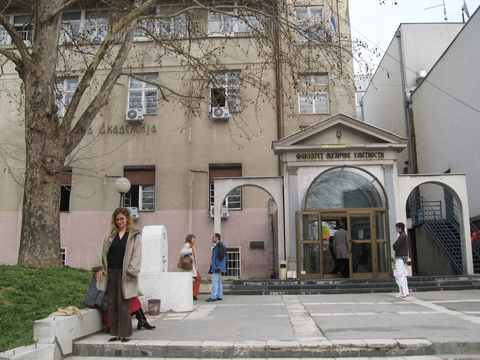




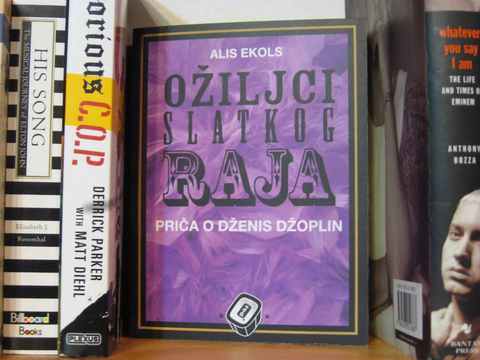 \
\